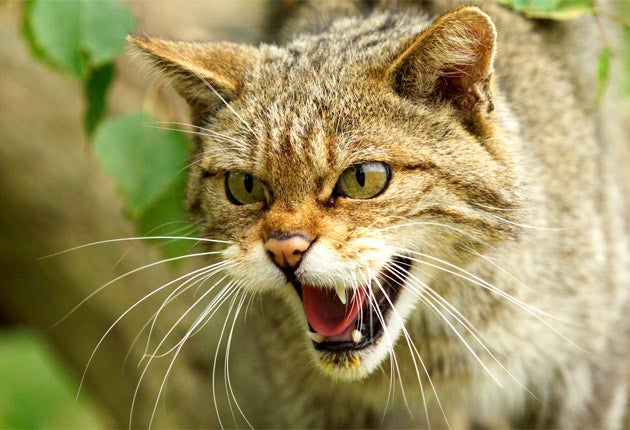'Enormous' wildcat caught on video in Scottish forest
Conservationists say 'beast' may be largest filmed to date and gives 'great boost' to threatened species hopes of survival

An “enormous” wildcat has been caught on camera prowling through Scottish woodland, in footage conservationists have declared “a great boost” for the threatened species.
The cat is estimated to have been around 4ft long and may be the largest filmed to date, according to Wildcat Haven, an organisation which monitors the dwindling population.
The predator – nicknamed “the beast” by the researchers who filmed it – was recorded by a hidden camera in Aberdeenshire‘s Clashindarroch forest.
Dr Paul O’Donoghue, chief scientific officer at Wildcat Haven, told The Independent: “I’ve seen every referenced cat in existence – so every pure Scottish wildcat recorded – this is the biggest one I’ve ever seen.
“It’s clearly a big, dominant male that’s in fantastic condition and it’s a great boost for the species.”
Some conservationists have previously doubted whether genetically “pure” Scottish wildcats remain in the region, but Dr O’Donoghue said: “This is the real deal, a pure Scottish wildcat. There is no doubt about that.”
The cat was recorded in December but the footage was only recently retrieved and viewed by researchers.
Field workers set up cameras activated by movement in areas they believe the animals to live, leave food or a scent as bait, and then wait for the cats to appear.
Kev Bell, the researcher responsible for looking after the camera which filmed the wildcat, said: “I couldn’t believe my eyes when I first saw this cat – he is enormous, a magnificent animal.”
Dr O’Donoghue added: “We were gobsmacked. You see its head coming in from the right and you think, ‘this is an interesting cat’. And the cat just keeps going and going. We were delighted. It’s a fantastic find.”
Researchers returned to the log where the cat was filmed and “calibrated the picture with the measurements” to estimate the size of the cat, the biologist added.
A typical male Scottish wildcat will grow up to about 3ft in length.

Dr O’Donoghue said Wildcat Haven had previously recorded 12 other wildcats in Aberdeenshire, “making this an incredibly important population for the survival of the species”.
The People’s Trust for Endangered Species list Scottish wildcats as “critically endangered”, with the species threatened by interbreeding with domestic cats, diseases, persecution, and habitat destruction.
But the number of pure wildcats remaining in existence is a subject of scientific debate.
The Scottish Wildcat Association estimates as few as 35 remain, making it one of the world’s rarest animals, while other research has put the figure at less than 400.
Some even fear pure wildcats are already extinct, although Wildcat Haven claimed its research disproved that conclusion.
“The cameras give us amazing insight to this priceless group of wildcats which have somehow survived here and avoided hybridisation,” Mr Bell said.
“Some people say that the wildcat doesn’t exist any more, but we know different and wildcats like ‘the beast’ prove it. This is nothing like a domestic cat, and you certainly wouldn’t want it sitting in your lap.”
However, Scottish Natural Heritage urged caution about drawing conclusions from footage alone.
Martin Gaywood, the public body’s policy manager for species projects, said genetic testing was required to establish a wildcat’s purity.
He added: “We are aware that there are wildcats in that area because we have been finding them ourselves, but we don’t know much about this one at this stage.”
Join our commenting forum
Join thought-provoking conversations, follow other Independent readers and see their replies
0Comments